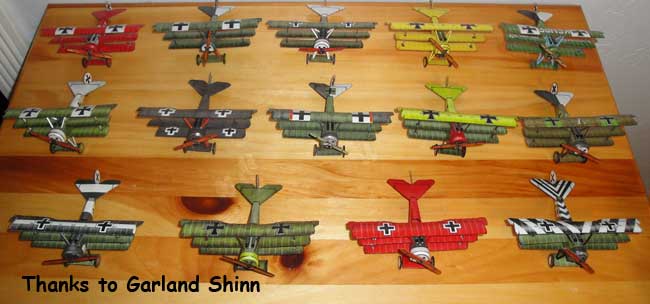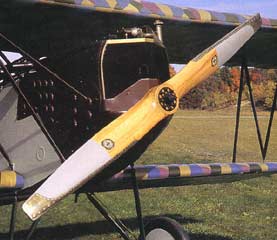

Fokker DVII Collection - $$15.95
20!! (plus) different versions in two scales! Display this fabulous Fokker Scourge hanging as a mobile from the ceiling. Sturdy and reliable in battle, Germany produced around 1,700 DVIIs in the summer and autumn of 1918. In service, the D.VII quickly proved itself superior to existing Allied fighters. This legendary aircraft is also available as just ONE model if you're so inclined. (see adjacent)
Fokker DVII - WWI Scout
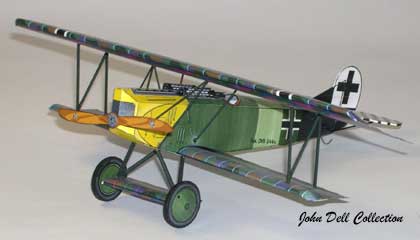
The Fokker DVII Collection
(as of April, 2010 there are 15 different versions)
More information on the Fokker DVII HERE
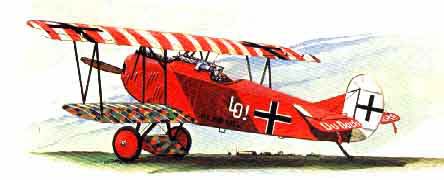 Only one thing detracted from the Fokker D-VII's reputation.
While it was winning battles in the air, the German army was losing
the war on the ground. Eventually, when the Armistice was signed
in November 1918, the DVII claimed a further place in the history
books by having its own special clause in the agreement. The Allies
insisted that Tony Fokker's D.Vlls were to be handed over to them.
No other aircraft was mentioned by name, and the Aihes took great
care that after the war large numbers of this remarkable aeroplane
were fed into giant heaps and set on fire. Nevertheless Fokker
managed to smuggle 60 trainloads of planes and parts out of Germany
into Holland, enabling him to set up his new company.
Only one thing detracted from the Fokker D-VII's reputation.
While it was winning battles in the air, the German army was losing
the war on the ground. Eventually, when the Armistice was signed
in November 1918, the DVII claimed a further place in the history
books by having its own special clause in the agreement. The Allies
insisted that Tony Fokker's D.Vlls were to be handed over to them.
No other aircraft was mentioned by name, and the Aihes took great
care that after the war large numbers of this remarkable aeroplane
were fed into giant heaps and set on fire. Nevertheless Fokker
managed to smuggle 60 trainloads of planes and parts out of Germany
into Holland, enabling him to set up his new company.
Towards the end of 1917, Anthony Fokker, conscious of the fact that he needed to re-establish his company's reputation as the leading German aircraft supplier, briefed his famous chief designer, Reinhold Platz, to produce a winner for the competition to choose,Germany's next front-line single-seat fighter.
Originally the new Fokker biplane was to be rotary engine, but structural problems with the wings of the latest Albatros meant that a large number of Mercedes DIII in-line engines became available at short notice. These beautiful engines, which delivered 160hp, were coming off the production line with no particular home for them, so Platz hastily revamped his design. One of these. designated VII, was chosen to represent Fokker at Adlershof airfield near Berlin in January 1918. Some 30 different designs were to be tested exhaustively by Germany's top pilots. and it was obvious that the winner would be assured a large production order.
What was kept very quiet indeed was Anthony Fokker's private fear that the new design would be inferior to some of the opposition in the competition. Brilliant salesman that he was, Fokker began to lobby the pilots before they flew the machine. He decided that he would turn the Fokker biplanes tendency to swing violently into a tactical advantage.
'You will notice a special feature of my ship, Herr Lieutenant', he said to ace Oberleutnant Bruno Loerzer. is its outstanding ability to turn quickly. Tell the others so they can all benefit.' Like one of its great Allied rivals, the Sopwith Camel, a potential weakness was turned into a tactical advantage. However, the factor that weighed most heavily in the aeroplane's fav our was its ability to hang on its propeller. This meant it could fight from below and literally chase an enemy across the sky pumping bullets into it almost at will.
|
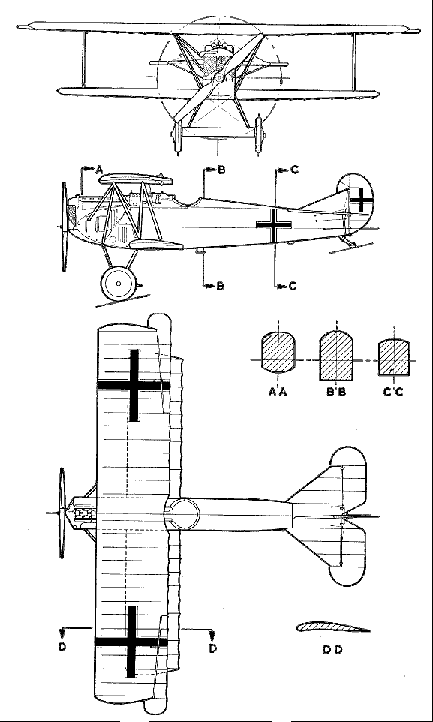 |
The Fokker DVII duly won the Adlershof competition and Anthony Fokker returned to the factory with an initial order for 400 aircraft. It must have been galling for Fokker's great rivals. Albatros Werke to receive a similar-size order to produce the Fokker biplanes under licence. It is to their credit that the Albatros-produced Fokkers were indistinguishable from the Fokker-built aircraft, despite the fact that they received no detailed plans or designs, but had to work entirely from one completed specimen aircraft.
The production model, the DVII. entered service in April 1918 and the first batch went to, Richthofen's famous flying circus, The Red Baron himself, who had tried the new Fokker at Adlershof and had recommended some minor modifications. few a DVII on several missions. However, it must be mentioned that he also remained faithful to his first love, the Fokker Dr. I triplane (Dr. standing for Dreidecker or three-winger). in which he tragically met his death on 21 April 1918.
In August 1918. a variant designated D.VIIF was first delivered, powered by a BMW IIIa engine. This developed an extra 20hp which gave it 200knVh performance and improved both rate of climb and service ceiling, cutting the time it took to reach an altitude 4800 ft from 38 minutes to just 14.
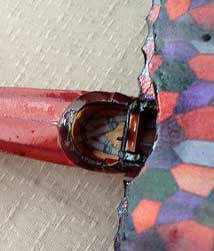 |
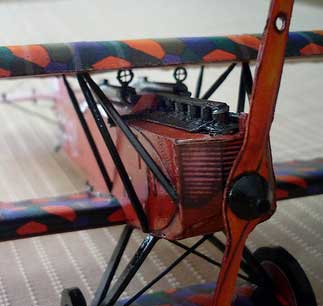 |
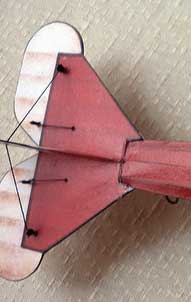 |
I just finished the original model of Fiddlers Green, the model has been improved, adding details to the cockpit, an engine that did not have (it was only printed), a new propeller, new weapons and control lines in their respective place, and added small details that we often forget such as handles to move the plane at the rear of the fuselage and a step to climb into the cockpit. Alejandro |
||
In many ways, the Fokker DVII was extremely orthodox, had taken all the best features of his earlier designs and built them into an extremely rugged airframe. The flying surfaces, with V-shaped interplane struts, were so well-braced that its pilots never experienced wing flutter even when carrying out the most extreme maneuvers.
After the Armistice astute Fokker and his newly assembled staff at the Amsterdam works put the smuggled DVIIs together and they sold like hot cakes. Among the more than a dozen customers for aircraft assembled from wartime parts were the new air forces of Belgium (occupied during the war) and Switzerland. The home air force bought large numbers for service both in the Netherlands and the East Indies. Even more important, the income from the sales of DVII immediately after the war enabled Fokker to expand the business, build Europe's best-selling airliners and follow the DVII with a series of even better fighters.
MORE about the Fokker DVII
Towards the end of 1917 the German IdFlieg (German abbr. for 'Inspectorate of Flying Troops') invited proposals for a new fighter scout equipped to compete with the recent new Allied aircraft and to succeed the Dr.1 triplane, then totally outclassed. The only condition was that this new fighter had to utilize the 160-hp Mercedes D III engine. The winner of the amazing total of 31 prototypes submitted for comparative trials at the Adlershof airfield near Berlin was the Fokker D.VII, one of nine submitted by Fokker. Anthony Fokker was determined not to lose this opportunity to submit a new winner which might be a worthy successor to his monoplanes and triplane's. The D.VII prototype, known by the designation V.11, was a sesquiplane, a 'one-and-a-half winger', with a decided difference in span between upper and lower wings, and it won a clear victory over all the other models submitted.
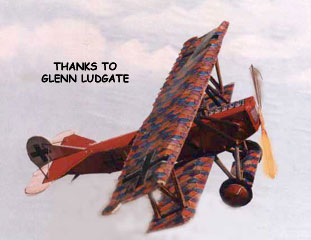
The design complies in every way with the concept of the simple aircraft formula defended by Reinhold Platz, now known to be its true creator, although Fokker claimed the design for himself. The V.11 was clearly based on the Dr.l triplane, from which it took virtually intact the fuselage and tail structure. In the original version the aircraft had lacked stability and was not easy to pilot, and when Fokker heard from Manfred von Richthofen, who took part in the tests at Adlershof, confirmation of the defects which he had already found, he decided that radical action was necessary.
He spread the word that the V 11 needed a few repairs as a result of a hard landing, then he took advantage of a weekend to assemble a few of his best workmen (who were at Adlershof as a maintenance crew) and by dint of incredibly hard and fast work succeeded in lengthening the fuselage by about 40 cm (16 inches).
Fokker's hunch paid off. Von Richthofen's original report on the V11 had been substantially negative, and Fokker invited him to try it again, confiding that over the weekend he had 'improved the controls'. The Red Baron tried the V.11 again and landed to report on it with enthusiasm. His prestige as a fighter pilot was such that his favorable opinion won the day for Platz's design, and it was thenceforth known as the D.VII (D indicated a single engine single-seat fighter scout of the German Imperial Air Force).
If today greater credit is given to Reinhold Platz as designer of the D.VII, Anthony Fokker's share must not be underestimated. His skill as a test pilot contributed a great deal to the day-to-day development of Platz's design and the building and perfecting of the prototype. The doughty Dutchman also had a talent for dealing with military authorities which the quiet and retiring Platz did not have.
The fine qualities of the new fighter scout were greeted enthusiastically
by other German pilots, who were willing to overlook its relatively
poor performance at altitude (the British S.E.5a and the French
SPAD XIII had far superior rates of climb). Moreover, the inferiority
of the D.VII from that point of view was not to last long, for
already during the competition Fokker and Platz had 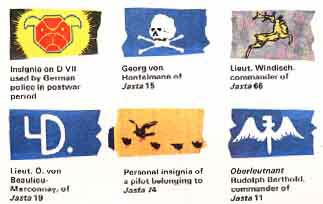 considered
the possibility of installing a more powerful engine.
considered
the possibility of installing a more powerful engine.
The two wing main planes were rectangular, each in a single piece, and of rather thick airfoil section. Both two-spar wings were of all-wood construction, covered with doped fabric. The trailing edge was of wire, with the characteristic form. The upper wing was attached by streamlined struts to the fuselage longer on heads and nacelle. The lower wing was designed so that the spars could pass through the fuselage by means of a special cutout in the lower longerons. Upper and lower wing spars were joined by N-struts quite close to the lower wing tips. A false dihedral effect resulted from the fact that the wings tapered in thickness towards the tips; upper surfaces were perfectly flat, and British pilots eventually came to call the D.VII 'old straight wings'. Stabilizer, rudder and ailerons were all balanced and rounded; the ailerons, rather small, were only on the upper wing.
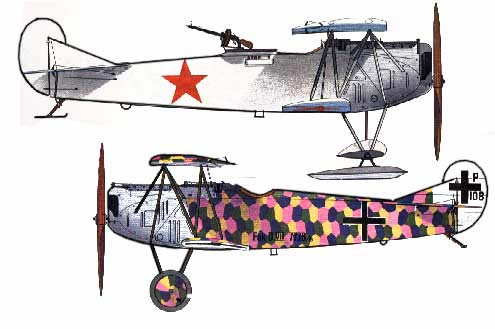 The overall structure of the D.VII was very
strong, light and rigid, giving it a decided structural superiority
over practically all other World War I fighters. Its toughness
pleased the German frontline pilots, and their confidence was
well founded: in spite of violent maneuvers in battle, daring
nose dives and hits from enemy fire, the D.VII rarely conked out.
The Fokker factory was notorious for the carelessness with which
it sometimes assembled its aircraft, but Platz's design was such
that even the production D.VII s from the Fokker plant were seldom
victims of the accidents which plagued the Dr.1 triplane's and
the E.V D.VIII monoplanes.
The overall structure of the D.VII was very
strong, light and rigid, giving it a decided structural superiority
over practically all other World War I fighters. Its toughness
pleased the German frontline pilots, and their confidence was
well founded: in spite of violent maneuvers in battle, daring
nose dives and hits from enemy fire, the D.VII rarely conked out.
The Fokker factory was notorious for the carelessness with which
it sometimes assembled its aircraft, but Platz's design was such
that even the production D.VII s from the Fokker plant were seldom
victims of the accidents which plagued the Dr.1 triplane's and
the E.V D.VIII monoplanes.
The undercarriage Vs were of streamlined steel tubing, and there was an airfoil lifting surface enclosing the axle, as on the Dr.l triplane. The shock-absorbers were not of the elastic-cord type then generally in use but incorporated spiral springs, a modification imposed by the scarcity of rubber in Germany. The stout ash tail skid was also connected to the fuselage by two spiral springs.
At first the D.VII was powered by the 160-hp 6-cylinder Mercedes D.III in-line engine, but as soon as it became feasible the manufacturers began to install the 185-hp BMW Illa, which could be boosted to as high as 240 hp for short spurts. This was also a 6-cylinder in-line engine, water-cooled and with a special carburetor. The greater power of the BMW engine enabled the D.VII to return a vastly superior performance to what it could do with the Mercedes. The D.VIIF, as it was known when powered by the BMW, had a maximum speed rating of 177 mph and a rate of climb which took it up to 20000 ft in less than 20 minutes.
The automobile-type radiator mounted just behind the two-bladed wooden propeller kept the D.VII from rivaling the Albatros from the esthetic point of view, but its simple, efficient circulation did ensure it against the problems that plagued other aircraft with more complicated cooling systems. Even when trying out other types of engines the position of the radiator remained unchanged, although larger radiators were needed with BMW engines than had been the case with the Mercedes.
Instrumentation was meager, in part because of the small size of the cockpit, and included only a tachometer, fuel pressure gauge, fuel and oil level gauges and compass; an altimeter was fitted only rarely. The metal fuel tank was in the forward section of the fuselage and was divided into three sections-one of 8 liters for oil, a 60-liter main fuel tank and a 30-liter reserve fuel tank. The BMW engine ran on a gasoline-benzene mixture, a recourse dictated by the lack of gasoline and the relative abundance of benzene. a coal-tar distillate.
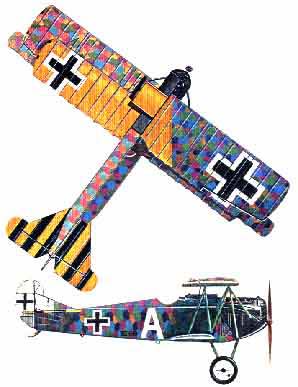 The pilot enjoyed fairly good visibility because of the shorter and narrower lower wing and a rather small cutout in the trailing edge of the upper wing above the cockpit. Apparently the shallowness of the cutout inconvenienced the taller pilots. |
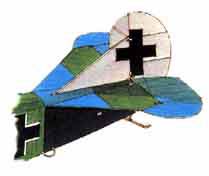 A slightly longer fuselage, a prominent curving fin (the V.11
had no fin) which was eventually to diminish to the narrow triangular
fin characteristic of the D.VII. Production aircraft with Mercedes
engines and those with BMW engines (practically indistinguishable
except for the difference in power plant) made up the bulk of
series D.Vlls. There were, in addition to these, derivative types
and experimental variants, among them the V.21, with slightly
raked wing tips and a special high compression-ratio Mercedes engine;
in spite of a slightly lower empty weight, its performance was
generally lower than that of the D.VI I. On the V.22 the wings
had been restored to the initial rectangular platform, introducing
a slight dihedral to the upper wing. There was a curious four bladed
propeller with the blades set at distances of 60° and 120°
(a Jaray-type air screw, roughly like an X). However, this variant
did not prove to be appreciably better than the series-production
model. The V.24 was a D.VII flown in 1918 with a 240-hp Benz Bz
IV engine; although climb rate was considerably improved, overall
performance was not satisfactory because the increased engine
weight hampered low-speed flight and maneuverability.
A slightly longer fuselage, a prominent curving fin (the V.11
had no fin) which was eventually to diminish to the narrow triangular
fin characteristic of the D.VII. Production aircraft with Mercedes
engines and those with BMW engines (practically indistinguishable
except for the difference in power plant) made up the bulk of
series D.Vlls. There were, in addition to these, derivative types
and experimental variants, among them the V.21, with slightly
raked wing tips and a special high compression-ratio Mercedes engine;
in spite of a slightly lower empty weight, its performance was
generally lower than that of the D.VI I. On the V.22 the wings
had been restored to the initial rectangular platform, introducing
a slight dihedral to the upper wing. There was a curious four bladed
propeller with the blades set at distances of 60° and 120°
(a Jaray-type air screw, roughly like an X). However, this variant
did not prove to be appreciably better than the series-production
model. The V.24 was a D.VII flown in 1918 with a 240-hp Benz Bz
IV engine; although climb rate was considerably improved, overall
performance was not satisfactory because the increased engine
weight hampered low-speed flight and maneuverability.
An experiment was made with a synchronized 12-mm heavy machine gun in place of the usual 7-92-mm gun to be used against aircraft and armored vehicles, and another with a Siemens machine gun with the interrupter synchronized with the propeller by a small electric motor.
In the summer of 1918 there appeared another two prototypes, the V.34 and V.36. The V.34 differed from the D.VII by having a small trapezoidal rudder in place of the rounded, comma-like control surface which had been a hallmark of so many Fokker models and installed without a vertical fin. The V.36 restored the traditional fin and rudder assembly but differed by having the fuel tank in the axle fairing. One reason for this unusual positioning of the tank was that the advanced development of tracer bullets and incendiaries meant that a single bullet could destroy an aircraft, since burning fuel either finished off the pilot or the fabric of the wings or tail. This undercarriage tank was used on various other Fokker machines but never on the D.VII.
The V.35 was simply a conversion of the D.VII into a two-seater by taking advantage of the space freed between pilot and engine by moving the fuel tank to the undercarriage axle fairing. From this variant there was derived the V.38, a liaison and reconnaissance aircraft of greater size and weight than the D.VII; it also was powered by the 185-hp BMW engine, which limited its performance. No military orders were ever proffered for the V.38 because of the Armistice, but some 70 machines of this type were built and crated up, and secretly taken to Holland after the war.
How the Fokker D-VII was used in the War
The first Fokker D-VII to reach front-line pilots was delivered in April 1918 to Manfred von Richthofen, and soon the several factories ordered to build the new fighter scout under license brought Fokker production up to such a rhythm that a good many other fighter units could be re-equipped with them.
The firms involved in the production of the D.VII included, besides the Fokker plant itself (which built about 370 of them), the Albatros Werke of Johannisthal and the Ostdeutsche Albatros Werke of Schneidemuhl; the AEG of Henningsdorf was to have been added to this list. An indication of the respect that the D.VII inspired on the opposing side: before long the Allies were convinced that the German Jastas had roughly twice as many of the 'straight wings' as they actually did have. Another tribute can be found in Article IV of the Armistice which detailed that the war materials to be handed over to the Allies should include '. . . especially all machines of the Fokker D.VII type. . .' In spite of the great compliment implicit in this condition, German airmen evaded it in various ways either by gently crashing on landing or by concealing their planes.
By bribery and other tricks Anthony Fokker managed to cart off to Holland, where production continued after the Armistice, six train loads of spare parts and raw materials, as well as 400 engines, and about 120 D.Vlls in crates (everything coming from the Schwerin plant, and all of it German military property), thus keeping it from the victorious Allies.
Official records show that after the Armistice the US Army brought not less than 142 Fokker D.Vlls to the States where they were used as advanced fighter-trainers for some time-apart from influencing the American aircraft designers for a dozen years or so (and starring in several Hollywood epics). |
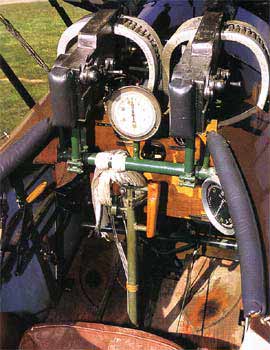 Controls included pedals, a control stick with grips for both hands, machine gun trigger, ignition, spark advance and starter booster coil. An emergency manual fuel pump was installed on the port side of the cockpit. |
A Fokker D-VII piloted by Ernst Udet was the first fighter scout to come off best in an encounter with an armored vehicle. Udet attacked a British tank six times, subjecting it to a concentrated fire and finally forcing it to overturn as it was trying to negotiate a rail bed. 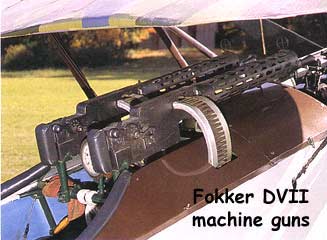 Armament consisted of a pair of the classic 7 92-mm LMG 08/15 machine guns, with 500 rounds each, fitted with a synchronizer giving a rate of fire of 600 rounds per minute through the propeller. |
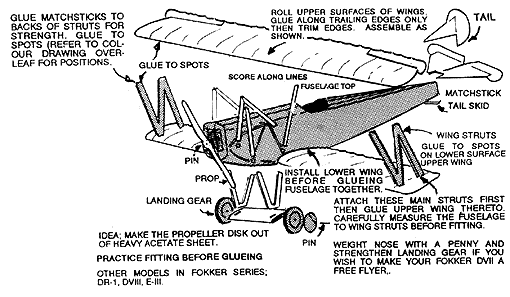 |
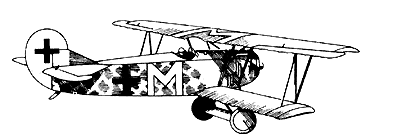 In action the D.VII soon proved to be the best plane the Germans had produced and better than most opposing fighters. |
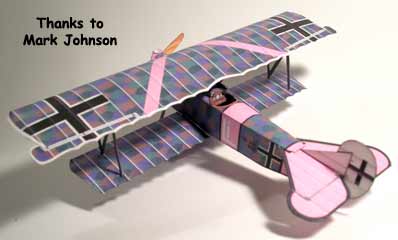 Fokker's talents as a businessman and operator, bolstered by
the unquestionable quality of the aircraft, ensured a long postwar
career for the D.VII. Belgian, Dutch and Polish airmen flew the
Fokker sesquiplane for many years, as did the fledgling air arms
of Denmark, Italy, Spain, Sweden, Switzerland and (after 1930)
Germany. The splendid climbing ability of the Fokker D.VII made it particularly
valuable in weather research. |
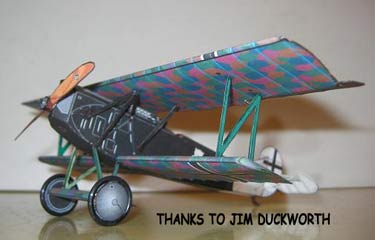 |
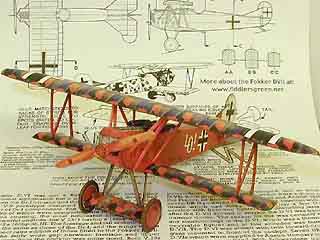 |
 |
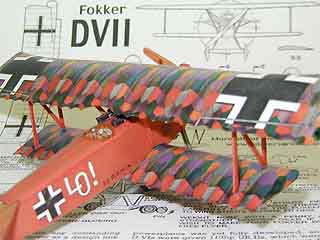 |
Thanks to longtime Modeln' Pal Wayne White |
||



